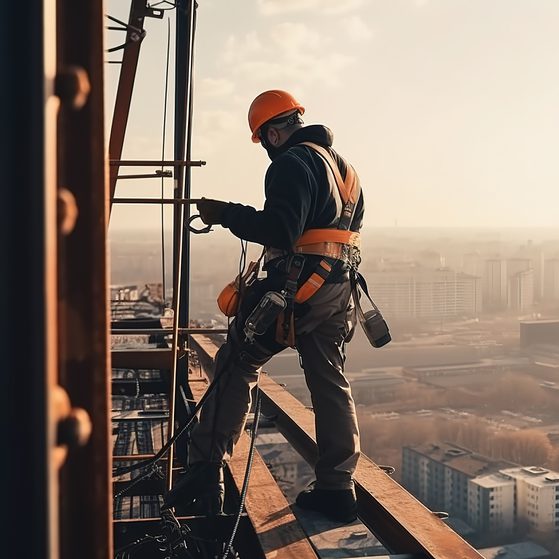We explore how the construction sector can proactively address mental health challenges through policy and training.
Read moreDuty holders — your legal obligations around RAAC and asbestos
AuthorsHannah HobsonClaire Burrows
13 min read

While over 500 English schools were recently deemed to be at ‘critical risk of sudden collapse’ due to their use of the building material RAAC, this isn’t the only dangerous material that building managers must be concerned about.
Each year, approximately 5,000 workers die as a result of asbestos — and a range of legal duties must be undertaken to ensure people’s health, safety and welfare and avoid costly legal, financial and criminal ramifications.
Here, Partner and health and safety law specialist Claire Burrows and Solicitor Hannah Hobson give a comprehensive overview of duty holders’ legal obligations when it comes to RAAC and asbestos risk assessment and management, and outlines a recent case where a company was fined £90,000 for its failure to comply with the relevant regulations.
Schools at ‘critical risk of sudden collapse’
Over the summer, more than 500 school buildings were found to contain reinforced autoclaved aerated concrete (RAAC) with 50 consequentially deemed to be at critical risk of sudden collapse.
A cheaper and more lightweight building material than traditional concrete, the risks associated with RAAC were known to the Government from approximately 1994, as some public buildings were found to be potentially compromised. While those buildings were monitored since 2018, unless the RAAC was deemed to be in a critical condition the buildings were considered safe to use.
This approach changed after an RAAC beam collapsed despite being deemed ‘low risk’. In light of this, the HSE (Health and Safety Executive) warned:
“If you are responsible for the management, maintenance or alteration of central and local government buildings you should know whether your buildings contain RAAC, and act appropriately to ensure that such buildings are safe.”
RAAC and asbestos surveys
In order for those responsible for managing and maintaining buildings to understand whether their buildings contain RAAC, they must undertake surveys to identify its presence and arrange for remediation works to be conducted.
Asbestos registers should also be inspected to ensure that any existing asbestos within the premises isn’t damaged or disturbed during the removal of RAAC. It’s important to note that, where a premises is at risk of sudden collapse due to RAAC, the remediation works may be postponed if the premises contains asbestos that is likely to be disturbed or damaged as a result of the remediation works. Should this arise, the asbestos must be removed before the RAAC remediation works take place. This approach will avoid further risks arising and additional breaches of relevant legislation.
Further to the recent concerns surrounding the use of RAAC, it’s anticipated that the management of asbestos will likely come under greater scrutiny in the coming months. While asbestos is a separate material to RAAC, it was used in various construction materials before being banned in 2000. It has since been an area of concern for the HSE. Notably, as of 6 March 2023, the HSE launched the ‘Asbestos & You’ campaign. While this is targeted at all tradespeople, it’s particularly relevant to younger construction workers who started their careers after the use of asbestos was prohibited and who may not be as aware of the significant risks associated with asbestos.
More recently, in January 2024, the HSE re-prioritised it’s ‘Asbestos – Your Duty’ campaign to highlight the risks associated with asbestos in buildings — particularly in workplaces, schools and hospitals. The purpose of the campaign is to enhance understanding and raise awareness as to what the duty to manage asbestos requires to ensure that people are safe. It’s aimed at duty holders responsible for managing asbestos in buildings.
As part of the campaign, explanatory videos and new templates — such as an asbestos management plan and an asbestos register with site plan — have been made available on the HSE website. This has also been updated in respect of managing asbestos in buildings, including guidance on the legal duty and what measures should be taken to comply with the relevant legislation.
The HSE has indicated that when conducting visits of buildings, inspectors will be checking how asbestos is managed and ensuring that appropriate arrangements have been implemented.
Asbestos — the risks
When asbestos-containing materials (ACMs) are disturbed, dangerous asbestos fibres are released into the air. When a person is exposed to (or inhales) such fibres, the person is at risk of developing a fatal or serious disease, such as mesothelioma, asbestos-related lung cancer, asbestosis and pleural thickening.
According to the HSE’s latest statistics, there were 2,268 mesothelioma deaths due to past asbestos exposures in 2021. Each year, approximately 5,000 workers die as a result of asbestos, with around 20 tradesmen dying each week as a consequence of past exposure to asbestos. The impact of exposure to asbestos is unlikely to be immediately obvious — in some cases, it can take as long as 20 to 30 years for the damage to develop and symptoms to appear.
In light of such risks, the HSE’s Chief Executive, Sarah Albon, stated:
“Asbestos exposure in Great Britain is still the single greatest cause of work-related deaths. We are committed to protecting people in the workplace and reducing future work-related ill health.”
While the use of asbestos was banned in 2000, the material is likely to be found in commercial and residential buildings built or refurbished prior to 2000, such as insulation materials, pipework, guttering and textured decorating coatings on walls and ceilings. For this reason, all buildings built before 2000 are presumed to contain asbestos, unless strong evidence exists to the contrary.
Legal duties around asbestos management
The law concerning the control and management of asbestos can be found in the Control of Asbestos Regulations 2012 (the Regulations). Regulation 4 sets out the duty to manage asbestos in non-domestic premises such as public, commercial or industrial buildings, including hospitals, schools, warehouses and offices. The ‘duty holders’ — the owners or those in control of the non-domestic premises (such as landlords) or the person or organisation responsible for the maintenance or repair of such premises (which could be the tenants) — are required to ensure that asbestos is managed correctly.
Where the premises is a public building, the duty holder will be determined by the allocation of maintenance. For example, in respect of a school, the duty holder is likely to be the employer (usually the local authority, school governors or academy trust — depending on the type of school).
In accordance with the Regulations, duty holders are required to proactively take reasonable steps to thoroughly inspect and survey the non-domestic premises to establish whether ACMs are present. This is usually achieved by appointing specialist contractors to undertake an asbestos management survey. If asbestos is identified or its presence cannot be excluded, duty holders must determine the location, type, condition and amount of asbestos found or presumed. This information should be recorded and kept up to date in an asbestos register.
It’s important to ensure that the condition of ACMs are assessed and inspected periodically (the frequency of inspections will depend on the condition of the ACMs and how likely they are to deteriorate or be disturbed). The asbestos register must then be made available to anyone who is likely to come into contact with the ACMs, including employees, tradespeople and emergency services. In circumstances where ACMs are likely to be damaged or disturbed by routine use of the premises, the duty holder must ensure specialist removal.
Asbestos risk assessments
A risk assessment must also be undertaken to assess the potential risk of anyone being exposed to fibres that arise from the identified materials. This will inform the production of the mandatory asbestos management plan which should detail:
- how the identified risks will be managed
- how and at what intervals the condition of the ACMs will be monitored
- any remedial works to repair, remove or protect the ACMs from damage or deterioration.
It’s the responsibility of the duty holder to ensure that the management plan is actioned or seek advice from an asbestos surveyor or other competent person who could assist.
In the event that a premises (or part of a premises) requires refurbishment, demolition or maintenance works, a further specialist survey must be undertaken (usually by a competent surveyor). A pre-refurbishment or pre-demolition survey is highly detailed and usually involves asbestos inspection, disturbance and destruction. The purpose of the survey is to locate and identify all ACMs before any works commence to ensure that nobody will be harmed as a result of the works, necessary control measures are in place and that the works are carried about by a competent contractor in the case of asbestos removal.
Liability and risk of harm
In most cases, a duty holder under the Regulations will also be a duty holder for the purpose of the primary piece of health and safety legislation — the Health and Safety at Work etc Act 1974 (the Act).
In accordance with the Act, every employer must ensure the health, safety and welfare of their employees and others (including members of the public, contractors and visitors) who may be affected by their undertakings. Failure to comply with the Act or the Regulations is a criminal offence which in the most serious cases can result in a criminal prosecution and severe penalties, including potentially unlimited fines (calculated by reference to turnover of the organisation, culpability and risk of harm) or imprisonment for individuals (such as directors or officers) when an organisation committed the offence with the consent or connivance of (or as a result of neglect on the part of) those individuals.
It's important to remember that actual harm doesn’t need to occur for an offence to have been committed under health and safety legislation (including the Regulations). A risk of harm is sufficient for a breach to have occurred. The HSE will not hesitate to prosecute companies, organisations and individuals that don’t discharge their legal obligations under the Regulations or the Act.
Construction company fined £90,000
A recent case provides a good example of this.
On 24 August 2023, Esskay Construction Ltd (the company) — a Warrington-based construction company — was fined £90,000 after it was found guilty of breaching Regulations 5 (identification of the presence of asbestos), 11 (prevention or reduction of exposure to asbestos) and 16 (duty to prevent or reduce the spread of asbestos). The company was also ordered to pay costs totalling £6,009 and a victim surcharge of £190.
The company was brought to the attention of the HSE after a concern relating to asbestos disturbance was received on 31 August 2021. During this time, the company was responsible for a renovation project on Brunswick Street in Hanley.
The local authority visited the company’s premises in response to the concerns. While visiting the site, large amounts of asbestos-containing debris were found along the public highway and at the front and rear of the building.
Two prohibition notices were issued by the HSE to prohibit all work activities and restrict access to the site and surrounding area. A licensed asbestos removal contractor was instructed to gain access to the premises and clean up the affected areas to ensure that they were safe.
The HSE’s investigation revealed that — prior to the commencement of the renovation works — the company had failed to appoint a competent person to undertake a refurbishment and demolition asbestos survey of the premises.
Despite not possessing any information concerning where the ACMs were located at the premises, the company permitted the refurbishment to continue, resulting in the ACMs being disturbed and potentially exposing workers and the public to harmful fibres.
When sentencing the company, the Court will have considered its annual turnover as prescribed in the sentencing guidelines to establish a starting point and category range for the level of fine. The Sentencing Council Guidelines for health and safety offences make it clear that “The fine must be sufficiently substantial to have a real economic impact which will bring home to both management and shareholders the need to comply with health and safety legislation.” In this case, the company’s annual turnover isn’t publicly available, but given the commentary from the HSE (below) about the nature of this breach and the stated purpose of fines for a health and safety offence, it’s assumed that the company’s turnover was relatively low to ensure the £90,000 fine was “sufficiently substantial”. The company will also have incurred expense for instructing the asbestos contractor to remedy the concerns at what is likely to have been short notice and premium rates.
Following the hearing, Will Gretton — a HSE inspector — highlighted the importance of duty holders complying with their duties under the Regulations. He stated:
“Asbestos is a class 1 carcinogen. Carelessness at this scale, met with a failure to attend court, is unacceptable.
“For that reason, any building constructed prior to the year 2000 must be assessed for the presence of asbestos prior to any disturbance work taking place, and any asbestos containing materials must be left undisturbed or be removed by a competent contractor under controlled conditions.
“By failing to take these simple steps, Esskay Construction Ltd put workers and members of the public at risk of being exposed to a substance known to cause fatal illnesses including mesothelioma, lung cancer and asbestosis.
“HSE will not hesitate to take action where contractors are found to be flouting the law and putting people at risk, and this case should serve as a reminder to those engaged in this type of work that they have responsibilities when it comes to managing the risks associated with asbestos.”
This case should act as a reminder to all owners and managers of non-domestic premises and those involved in the management of asbestos that failure to comply with the Regulations — and in turn ensure the health, safety and welfare of their employees and the health and safety of those affected by their undertakings — may result in enforcement action by the HSE, criminal convictions, financial penalties and reputational damage.
Individual handed an 18-month community order
Action by the HSE for failings involving asbestos will not be limited to corporate bodies — as demonstrated by a recent case in which an individual was handed an 18-month community order and ordered to pay £1,000 in costs.
The prosecution arose after the individual pleaded guilty to six separate charges, including contravening Regulations 8(1) and 20(3) of the Control of Asbestos Regulations 2012 and breaching Section 33 (1)(m) of the Health and Safety at Work etc. Act 1974. As part of the order, the individual will be required to complete 150 hours of unpaid work, 15 days of rehabilitation and 90 days of monitored alcohol abstinence.
On 15 January 2024, it was reported that an investigation undertaken by the HSE revealed that the person concerned had illegally removed asbestos from a school in March 2021, despite not holding a licence to do so. Having received training concerning the safe removal of licenced asbestos, the individual would have been aware of the legal requirement to hold a licence.
The individual had failed to ensure that a four-stage clearance was undertaken by a person accredited by an appropriate body and had purposefully falsified clearance paperwork. This wasn’t an isolated event, as similar works had been carried out at a domestic property in November 2020.
Talk to us
If you need help to arrange for specialists to assess buildings for RAAC and/or asbestos — or if you need advice and guidance to ensure compliance with relevant regulations — our dedicated health and safety law team can help.
We support on all aspects of health and safety law, including conducting site visits and inspections to assess compliance and provide gap analysis, offering specialist consultancy services and providing strategic advice and legal opinion.
If the worst happens, our crisis management experts can also support clients through regulatory investigations and interventions.


Talk to us
Loading form...


